 By Bob Currie, Recreational Boating Safety Specialist
By Bob Currie, Recreational Boating Safety Specialist
U. S. Coast Guard Auxiliary Station Galveston Flotilla
I have written many articles about required and recommended safety equipment, and I have included shoes in some discussions, but I have never written an article based solely on shoes and their lifesaving importance. This column will discuss the various types of shoes and whether they make good boat shoes or not. Here is what we are looking for in a boat shoe:
- Nonslip
- Non-marking (won’t make marks on the deck)
- Protect your feet from bumping your toes.
- Protect your feet from sunburn
- Protect your feet in the water from oyster shell and debris
- Will not come off easily in the water (a good thing)
- Stylish (not many safety devices can also be stylish, but shoes can!)
Steel Toe Boots
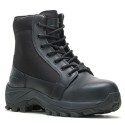 Have you ever wondered what the professionals wear on boats and ships? Well, in the Coast Guard and Coast Guard Auxiliary we wear steel toe boots. Those boots weigh from 1.5-3 pounds each. You might think that steel toe boots would really weigh you down if you ended up in the water, but the downward force they produce is easily overcome with some minor feet kicking. One thing about it- they will definitely protect your feet from the razor sharp oyster shells prevalent in Gulf of Mexico waters. But face it- steel toe boots come in last in the recreational boating shoe category. There is no recommendation to wear steel toe boots. This is just to let you know what the pros wear. These boots are (1) nonslip, (2) will make black marks on the deck, (3) will protect your toes, (4) will protect from sunburn, (5) will protect your feet in the water, (6) will not come off easily in the water, but they are (7) not stylish unless you are in full uniform.
Have you ever wondered what the professionals wear on boats and ships? Well, in the Coast Guard and Coast Guard Auxiliary we wear steel toe boots. Those boots weigh from 1.5-3 pounds each. You might think that steel toe boots would really weigh you down if you ended up in the water, but the downward force they produce is easily overcome with some minor feet kicking. One thing about it- they will definitely protect your feet from the razor sharp oyster shells prevalent in Gulf of Mexico waters. But face it- steel toe boots come in last in the recreational boating shoe category. There is no recommendation to wear steel toe boots. This is just to let you know what the pros wear. These boots are (1) nonslip, (2) will make black marks on the deck, (3) will protect your toes, (4) will protect from sunburn, (5) will protect your feet in the water, (6) will not come off easily in the water, but they are (7) not stylish unless you are in full uniform.
Sperry Boat Shoes
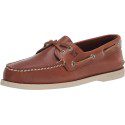
Sperry is a brand name, and their boat shoes are often copied by other manufacturers. The Sperry type shoes have a special nonslip sole that looks like a series of slices in the material. As you walk those slices open and grip the boat deck. This style of shoe is popular with nonboaters as well. The leather laces are designed to tighten the fit at the heel, which makes it harder for them to come off easily. That said, if you find yourself standing in thick silt, the shoes could come off easily and be lost, so if you use this style, make sure that you adjust them so they don’t come off easily. These shoes are (1) nonslip, (2) will not make marks on the deck, (3) protect your toes, (4) protect from sunburn, (5) protect your feet in the water, (6) will not come off easily in the water, and they are (7) quite stylish.
Crocs
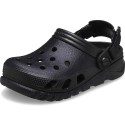 Crocs, like Sperry, is a name brand that people automatically associate with a particular style of shoe. They are basically plastic-covered foam slip-on shoes that were first popular with nurses and doctors in the hospital, as you could stand all day and your feet would remain comfortable. While they are quite comfortable, they will come off your feet within six tenths of a second should you fall overboard, especially if you wear them with the heel strap folded forward as most people do. Many styles of these shoes have holes across the top, such as the one pictured here. Those little holes will make the top of your feet look quite strange due to the skin beneath the holes becoming sunburned. These shoes are (1) nonslip, (2) will not make marks on the deck, (3) will protect your toes, (4) will not completely protect from sunburn, (5) will protect your feet in the water if you could only keep them on your feet, (6) will come off very easily in the water, and they are (7) stylish due to their popularity.
Crocs, like Sperry, is a name brand that people automatically associate with a particular style of shoe. They are basically plastic-covered foam slip-on shoes that were first popular with nurses and doctors in the hospital, as you could stand all day and your feet would remain comfortable. While they are quite comfortable, they will come off your feet within six tenths of a second should you fall overboard, especially if you wear them with the heel strap folded forward as most people do. Many styles of these shoes have holes across the top, such as the one pictured here. Those little holes will make the top of your feet look quite strange due to the skin beneath the holes becoming sunburned. These shoes are (1) nonslip, (2) will not make marks on the deck, (3) will protect your toes, (4) will not completely protect from sunburn, (5) will protect your feet in the water if you could only keep them on your feet, (6) will come off very easily in the water, and they are (7) stylish due to their popularity.
Sailing Shoes
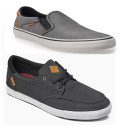 This type of shoe is commonly called a sailing shoe or a deck shoe. They can either be the lace-up type or the slip-on type. They are what I call a semi-specialized shoe in that many people who have nothing to do with boats wear this type of shoe for its light weight and styling. Most have a non-slip sole and are quite comfortable on or off the boat. Most shoe manufacturers have this style of shoe in their catalog due to its popularity. Some advertise it as a boat shoe, some as a deck shoe, and some manufacturers have different names for the style. If you purchase a pair, be sure to look for a good non-slip sole. One good feature of these shoes is that they are washable, and they dry on your feet fairly quickly if you get your feet wet while launching your boat. You don’t want to slosh around all day with wet feet. These shoes are (1) nonslip, (2) will not make marks on the deck, (3) protect your toes, (4) protect from sunburn, (5) protect your feet in the water, (6) will not come off easily in the water, and they are (7) stylish.
This type of shoe is commonly called a sailing shoe or a deck shoe. They can either be the lace-up type or the slip-on type. They are what I call a semi-specialized shoe in that many people who have nothing to do with boats wear this type of shoe for its light weight and styling. Most have a non-slip sole and are quite comfortable on or off the boat. Most shoe manufacturers have this style of shoe in their catalog due to its popularity. Some advertise it as a boat shoe, some as a deck shoe, and some manufacturers have different names for the style. If you purchase a pair, be sure to look for a good non-slip sole. One good feature of these shoes is that they are washable, and they dry on your feet fairly quickly if you get your feet wet while launching your boat. You don’t want to slosh around all day with wet feet. These shoes are (1) nonslip, (2) will not make marks on the deck, (3) protect your toes, (4) protect from sunburn, (5) protect your feet in the water, (6) will not come off easily in the water, and they are (7) stylish.
Flip Flops
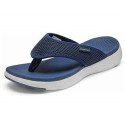 I see many boaters and their passengers wearing this style of shoe. They aren’t even safe on dry land. Many a person has been injured wearing this style of shoe. They may be good for the beach or as house slippers, but not safe for wearing on the boat. While they may have a non-slip sole, if your feet become wet they easily slide out of flip flops, especially sliding off to the side causing you to fall. They also are gone in a flash if you end up in the water. I live at the beach, and all the locals say you can tell another local by their flip flop suntan lines. You can be shunned for not having tanned toes. Besides being dangerous when they are wet, they are particularly dangerous when navigating stairs as they offer no side support to your feet. These shoes are (1) slippery when wet, (2) will not make marks on the deck, (3) do not protect your toes, (4) do not protect from sunburn, (5) will not stay on in the water, (6) will come off easily in the water, but they are (7) stylish.
I see many boaters and their passengers wearing this style of shoe. They aren’t even safe on dry land. Many a person has been injured wearing this style of shoe. They may be good for the beach or as house slippers, but not safe for wearing on the boat. While they may have a non-slip sole, if your feet become wet they easily slide out of flip flops, especially sliding off to the side causing you to fall. They also are gone in a flash if you end up in the water. I live at the beach, and all the locals say you can tell another local by their flip flop suntan lines. You can be shunned for not having tanned toes. Besides being dangerous when they are wet, they are particularly dangerous when navigating stairs as they offer no side support to your feet. These shoes are (1) slippery when wet, (2) will not make marks on the deck, (3) do not protect your toes, (4) do not protect from sunburn, (5) will not stay on in the water, (6) will come off easily in the water, but they are (7) stylish.
Summary
While shoes are not a listed safety item on the US Coast Guard Vessel Safety Check, they do bear mentioning when making recommendations. I will often ask a boater during a Vessel Safety Check, “Are those the shoes you wear on the boat?” I then mention the importance of having shoes that will both protect you on board and in the water. Although you can wear any type of shoe or boot on the water, you should know the shortcomings of the style you have chosen and act accordingly. When you invite people aboard your boat for an outing, be sure to make your recommendations for footwear, as you could save a life by having your passengers wear a safe type of shoe.
Side Note
About three years ago two men operating a sailboat in Galveston East Bay had their tag line foul their auxiliary engine propeller. Both men went over the side to try to clear the line from the propeller. One man was barefooted and the other had flip flops, which he promptly lost when he hit the water. They did not anchor, and a gust of wind separated the men from the boat. One man was wearing a life jacket and one was not. They found themselves in three to four feet deep water. They could have walked to shore had they only had good shoes, but they were in the middle of an oyster bed and could not put their bare feet down to stand up. They tried to swim to shore, a matter of a few hundred yards, but were stopped by the strong current. While a life jacket will support one person in the water, it will not support two people. The man without a life jacket drowned. The man with a life jacket was rescued after about 48 hours in the water. His feet were shredded from the sharp oyster shells in the oyster bed. He was near death when rescued. This happened in my back yard (so to speak). The sea teaches us many hard lessons. It is up to us to learn from them.
[BC: Sep-12-2023]

 Posted in
Posted in 























